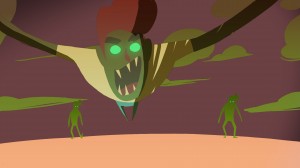
Leading up to TEDYouth, students explore the world behind TED-Ed lessons

On the eve of TEDYouth, the TED-Ed office was abuzz with activity beyond the normal day-to-day. Over fifty students from all over New York City and the tri-state area gathered in the front of the TED office for a pre-TEDYouth Animation Workshop — in which several TED-Ed Animators, a TED-Ed Educator, and a producer were present to answer questions and give the inside scoop behind three very popular TED-Ed lessons.
After an introduction by TED-Ed Programs Director Stephanie Lo, the group of budding animators, math and science enthusiasts, creative thinkers and several very good puzzle-solvers (a spontaneous Rubik’s Cube challenge occurred at one point during the night) were ready to pepper the TED-Ed staff with questions about the TED-Ed Lessons and the ins and outs of a career in animation.
The first lesson shown was Tim Verstynen & Bradley Voytek’s “Diagnosing a zombie: Brain and behavior,“ which explains how doctors diagnose illnesses using a hypothetical zombie patient as an example. Animator Franz Palomares was on hand to answer questions, and he got some good ones, including:
- A lot of people think of the stereotypical zombie as this green, rotting corpse — why did you do yours more on the human side? Franz’s answer? Because the lesson focuses more on determining what in the brain makes the zombie act like it does as opposed to a back story for the zombie, so it made sense to make its human elements recognizable.
- How important is picking colors? Very important, says Franz. If you pick the wrong colors, a character can fade into the background of an animation and go unnoticed.
- How did you get involved in doing animation? What inspired you to do this? Bugs Bunny (and a few others).
Next up was Michael Molina’s “The Pangaea Pop-up,” creatively made by TED-Ed’s Biljana Labovic and Lisa LaBracio using a pop-up book and stop-motion animation. Lisa explained the complex process behind animating a pop-up book and answered questions from the crowd:
- I’ve learned that it takes an extremely long time to make any stop motion video. How long did this [4 minute] video take? Lisa recalled that the actual animating meant almost living in the animation studio for more than eight hours a day for seven days.
- Do you know how many pictures it took to make? Each page required around 100-150 photos for the animation, Lisa said, but one page in particular was especially complex and took around 600 photos to animate.
- “If I want to start animating, how should I start?” Get an app for your phone and start experimenting, she says.
Next, animator Jeremiah Dickey and educator Alex Rosenthal were on hand for Alex and George Zaidan’s “The Case of the Missing Fractals.” The pair explained how math and film noir inspired the narrative-driven fractal explainer. A few questions from the night:
- Which movies did you watch to inspire ideas for the lesson?” Jeremiah: Raw Deal — “the original one.” Alfred Hitchcock’s Vertigo.
- What was Pandora’s box supposed to represent? Alex: The interesting thing about Mandelbrot, this guy who known as the father of fractals, is that when he started looking into [fractals], he found that fractals are all over nature … The mythology behind this video is that this is a world where instead of everything being fractals, everything is platonic solids … The Pandora’s box is a portal into the world of fractals, which is our world.
- When you’re drawing, do you have to do a lot of shading? Jeremiah definitely does. And does a good amount by hand.
And to end the night, TED-Ed producer Gerta Xhelo, who helped produce Matthew Winkler’s “What makes a hero?“, explained what it’s like to produce a lesson. Some questions:
- What is your favorite thing you’ve worked on? This animation. Seriously. But: I change my mind constantly.
- How long was the process to make this animation? For this one — about three months total.
- How many people work on a TED-Ed video? For this, seven people, but some lessons are made by only one or two people.
Want to see more animation? Check out TED-Ed’s library of lessons or this series on the basics of animation. >>




HMMMMM…… I don’t know about the zombie cat.